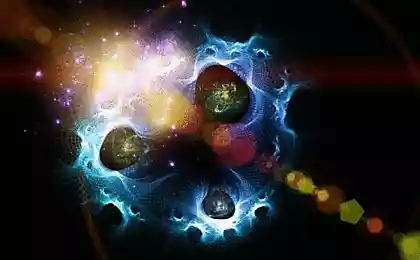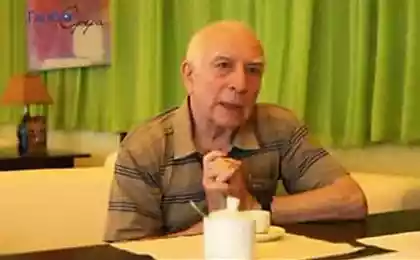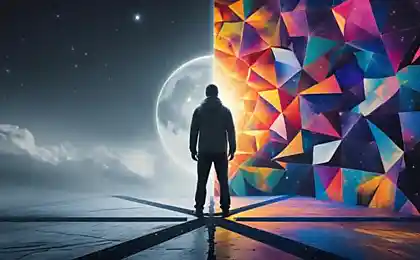598
The reality of quantum weirdness
Do you believe that the Moon exists only when you look at her?
The question of albert Einstein accumulates as the essence of continuing a hundred years of scientific debate about the problems of measurement and the essence of the nature of the wave function.

In the film Akira Kurosawa's "rashomon" samurai kill, but from the film and it is not clear who and why? Various involved in the story characters tell their version of these events, but all their testimonies contradict one another. And as a result you remain in doubt: Which of these stories is the truth?
But this film makes you think about the other, deeper question:
"Is there a true story or all of our faith in specific, objective, independent of the observer reality is an illusion?"
Published in the journal Nature Physics article provides new experimental data to support the last scenario of the existence of a "rashomon effect" not just in our descriptions of nature, but in nature itself.
Over the past hundred years, numerous experiments on elementary particles have upended and put on his head the whole classical paradigm of a causal, deterministic universe.
Take, for example, the so-called double-slit experiment. We shoot a bundle of elementary particles — say, electrons — in screen, capable of registering their impact. But before we put the partly passable obstacle: a wall with two thin parallel vertical cracks. We look at the resulting pattern of electrons appearing on the screen. And what do we see?
If the electrons were like little balls of (what forced us to believe classical physics), then each of them would have slipped through one of the slits, and thus we would see on the screen two separate stripes, each over its slit. But in fact, we see something quite different: an interference pattern, as if the two waves clashed, creating ripples on the water.
And surprisingly, the same thing happens if we start to shoot electrons at a time — that suggests that every electron in some way acts like a wave, interfering with itself as if it passed through both slits at the same time.
That is, the electron is a wave, not a particle? Do not jump to conclusions. Because when we put the slots devices which "tag" the electrons in accordance with the slit through which they pass (which allows us to know their whereabouts), the interference pattern disappears. Instead, we see on the screen two classic strips like our electrons, suddenly realizing that they are being watched, decided to behave like a decent little balls.
To test this, their commitment to behave like particles, we can mark them when passing through the cracks — but after that, using other device, to erase the marks before the electrons hit the screen. If we do this, the electrons return to their vanapagana behavior, and the interference pattern miraculously appears again.
There is no end to the various practical jokes we can play on the poor electrons! But with a tired smile, he always laughs at us in response. The electron seems to us a strange hybrid of waves and particles about which I can neither say that it's here and there, or he's here or there. Like a well trained actor, he plays the role that was intended to fulfill. As if all his existence he decided to prove us faithful to the known maxims of Bishop George Berkeley:"to be is to Be perceived".
Whether nature really that weird? Or is it just a seeming oddity, which is a reflection of our imperfect knowledge of nature?
The answer depends on how you interpret the equations of quantum mechanics — mathematical theory developed to describe the interaction of elementary particles. The success of this theory has no equal. Her predictions, no matter how "weird" they may seem, were always checked and confirmed by observations with amazing accuracy. It also provided the basis for remarkable technological achievements. So it's a really powerful tool. But is it also a reflection of reality?
In this sense, one of the biggest issues here is the interpretation of the so-called wave functiondescribing the state of a quantum system. For individual particles such as the electron, the wave function gives information about the probability of observing a given particle in certain places, as well as the probabilities of the results of other measurements you can do on this particle, for example, measuring her pulse.
Does this directly the wave function of some objective, observer-independent physical reality, or maybe she just represents a partial knowledge of the observer about this reality?
If the wave function is based on knowledge, then you can give justification strange quantum phenomena, saying that such things merely appear to us in such a strange way, as our knowledge of the real state of Affairs is insufficient.
However, a new article in the journal Nature Physics provides convincing evidence that it is not. The conclusions of this article are based on the results of the experiments using beams of specially prepared photons to check for certain statistical properties of quantum measurements. If an objective reality exists at all, the article just demonstrates that the wave function is based still not on knowledge, but on reality.
That is, the findings of this study imply that we are not just hearing different "stories" about the electron, only one of which is true. Rather, there is indeed one true story but it contains a lot of faces that seem contradictory, just like in the film "rashomon". So, really we won't be able to get out of this mysterious — some say mystical — nature of the quantum world.
But what does it all mean for us (if it really means something) in our own life? We must here be careful in the conclusions, realizing that all that quantum weirdness does not imply directly the existence of the same kind of weirdness in the world of our everyday experience. The reason is that as you know, all this vague quantum strangeness individual elementary particles dissipates quickly in large ensembles of particles (a phenomenon which is often called "decoherence"). That is why we actually can describe the objects around us in the language of classical physics.
I think we rather should consider all of these paradoxes of quantum physics as a metaphor, pointing to the unknown infinite possibilities of our own existence.
Very appropriate and elegant this idea is expressed in the Vedas:
"What is the atom so is the universe; what is the microcosm and the macrocosm; what the human body is and body space; what is human thought, so the thought of space".published
Author: Edward Frenkel
P. S. And remember, only by changing their consumption — together we change the world! ©
Source: larkin-donkey.livejournal.com/211489.html#cutid1
The question of albert Einstein accumulates as the essence of continuing a hundred years of scientific debate about the problems of measurement and the essence of the nature of the wave function.

In the film Akira Kurosawa's "rashomon" samurai kill, but from the film and it is not clear who and why? Various involved in the story characters tell their version of these events, but all their testimonies contradict one another. And as a result you remain in doubt: Which of these stories is the truth?
But this film makes you think about the other, deeper question:
"Is there a true story or all of our faith in specific, objective, independent of the observer reality is an illusion?"
Published in the journal Nature Physics article provides new experimental data to support the last scenario of the existence of a "rashomon effect" not just in our descriptions of nature, but in nature itself.
Over the past hundred years, numerous experiments on elementary particles have upended and put on his head the whole classical paradigm of a causal, deterministic universe.
Take, for example, the so-called double-slit experiment. We shoot a bundle of elementary particles — say, electrons — in screen, capable of registering their impact. But before we put the partly passable obstacle: a wall with two thin parallel vertical cracks. We look at the resulting pattern of electrons appearing on the screen. And what do we see?
If the electrons were like little balls of (what forced us to believe classical physics), then each of them would have slipped through one of the slits, and thus we would see on the screen two separate stripes, each over its slit. But in fact, we see something quite different: an interference pattern, as if the two waves clashed, creating ripples on the water.
And surprisingly, the same thing happens if we start to shoot electrons at a time — that suggests that every electron in some way acts like a wave, interfering with itself as if it passed through both slits at the same time.
That is, the electron is a wave, not a particle? Do not jump to conclusions. Because when we put the slots devices which "tag" the electrons in accordance with the slit through which they pass (which allows us to know their whereabouts), the interference pattern disappears. Instead, we see on the screen two classic strips like our electrons, suddenly realizing that they are being watched, decided to behave like a decent little balls.
To test this, their commitment to behave like particles, we can mark them when passing through the cracks — but after that, using other device, to erase the marks before the electrons hit the screen. If we do this, the electrons return to their vanapagana behavior, and the interference pattern miraculously appears again.
There is no end to the various practical jokes we can play on the poor electrons! But with a tired smile, he always laughs at us in response. The electron seems to us a strange hybrid of waves and particles about which I can neither say that it's here and there, or he's here or there. Like a well trained actor, he plays the role that was intended to fulfill. As if all his existence he decided to prove us faithful to the known maxims of Bishop George Berkeley:"to be is to Be perceived".
Whether nature really that weird? Or is it just a seeming oddity, which is a reflection of our imperfect knowledge of nature?
The answer depends on how you interpret the equations of quantum mechanics — mathematical theory developed to describe the interaction of elementary particles. The success of this theory has no equal. Her predictions, no matter how "weird" they may seem, were always checked and confirmed by observations with amazing accuracy. It also provided the basis for remarkable technological achievements. So it's a really powerful tool. But is it also a reflection of reality?
In this sense, one of the biggest issues here is the interpretation of the so-called wave functiondescribing the state of a quantum system. For individual particles such as the electron, the wave function gives information about the probability of observing a given particle in certain places, as well as the probabilities of the results of other measurements you can do on this particle, for example, measuring her pulse.
Does this directly the wave function of some objective, observer-independent physical reality, or maybe she just represents a partial knowledge of the observer about this reality?
If the wave function is based on knowledge, then you can give justification strange quantum phenomena, saying that such things merely appear to us in such a strange way, as our knowledge of the real state of Affairs is insufficient.
However, a new article in the journal Nature Physics provides convincing evidence that it is not. The conclusions of this article are based on the results of the experiments using beams of specially prepared photons to check for certain statistical properties of quantum measurements. If an objective reality exists at all, the article just demonstrates that the wave function is based still not on knowledge, but on reality.
That is, the findings of this study imply that we are not just hearing different "stories" about the electron, only one of which is true. Rather, there is indeed one true story but it contains a lot of faces that seem contradictory, just like in the film "rashomon". So, really we won't be able to get out of this mysterious — some say mystical — nature of the quantum world.
But what does it all mean for us (if it really means something) in our own life? We must here be careful in the conclusions, realizing that all that quantum weirdness does not imply directly the existence of the same kind of weirdness in the world of our everyday experience. The reason is that as you know, all this vague quantum strangeness individual elementary particles dissipates quickly in large ensembles of particles (a phenomenon which is often called "decoherence"). That is why we actually can describe the objects around us in the language of classical physics.
I think we rather should consider all of these paradoxes of quantum physics as a metaphor, pointing to the unknown infinite possibilities of our own existence.
Very appropriate and elegant this idea is expressed in the Vedas:
"What is the atom so is the universe; what is the microcosm and the macrocosm; what the human body is and body space; what is human thought, so the thought of space".published
Author: Edward Frenkel
P. S. And remember, only by changing their consumption — together we change the world! ©
Source: larkin-donkey.livejournal.com/211489.html#cutid1
Psyllium: the incredible benefits of a gluten-free flour from plantain
How many years will your marriage last? Factors match in a relationship























